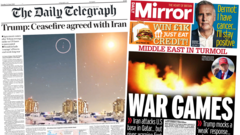What Makes Lena Dunham Reflect on Girls' Most Iconic Line 13 Years Later?

## Unpacking the Role of Voices in Modern Storytelling
In today's rapidly evolving landscape of television and film, the notion of a singular "voice of a generation" is increasingly being challenged. No longer can one individual claim to represent the multifaceted experiences of an entire group, be it gender, ethnicity, or sexual orientation. This sentiment is echoed by many contemporary creators who are committed to showcasing a diversity of narratives that resonate on personal and cultural levels. The richness of stories told across platforms is not only a testament to the talent of modern writers and directors but also an essential part of how society engages with complex issues.
### The Complexity of Representation
The conversation around representation in media has gained momentum, particularly in the wake of shows that challenge traditional narratives. The statement that "no one can be the voice of women" encapsulates the idea that women's experiences are varied and cannot be distilled into a single narrative. Instead, the diversity of voices allows for a broader understanding of what it means to be a woman, a person of color, or part of the LGBTQ+ community.
#### The Importance of Diverse Perspectives
1. **Cultural Nuances**: Each community has its own unique experiences shaped by culture, history, and social context. Acknowledging these nuances allows creators to tell stories that resonate more authentically with their audiences.
2. **Broadening Horizons**: By showcasing different perspectives, media can help audiences understand experiences outside their own, fostering empathy and greater social awareness.
3. **Encouraging Dialogue**: Diverse narratives spark conversations about identity, societal norms, and cultural expectations, leading to more inclusive discussions in both media and society.
### Celebrating Unique Experiences
Modern creators, like Lena Dunham and her collaborators, emphasize the importance of telling specific stories that reflect individual experiences. For instance, exploring what it was like to grow up queer in the early 2000s in Nottingham opens up discussions about the intersectionality of identity, sexuality, and place.
#### The Role of British Television
British television has often been at the forefront of introducing fresh voices and unique storytelling formats. Shows like "What It Feels Like For A Girl" exemplify this trend, offering intimate insights into personal narratives. When new creators bring their experiences to the screen, they foster a culture of storytelling that is both relatable and thought-provoking.
### The Evolution of Creative Collaboration
In recent interviews, actors and creators have shared insights into their collaborative processes. The relationship between an actor and director, especially when they share a history, can lead to a dynamic creative environment. The excitement of working with someone who has a distinct vision and a wealth of experience can elevate a project.
#### Learning from Each Other
- **Mutual Growth**: Actors often learn from directors, and vice versa. This exchange of ideas enhances the storytelling process, making it richer and more complex.
- **Creating Safe Spaces**: Good collaboration fosters an environment where all voices can be heard, allowing for more innovative and authentic storytelling.
### The Emotional Spectrum of Storytelling
One of the hallmarks of shows created by writers like Dunham is their ability to balance humor and pathos. The emotional rollercoaster that a viewer experiences—laughing one moment and crying the next—shows the depth of human experience.
#### The Power of Authentic Moments
- **Real Connections**: Authenticity in storytelling creates a connection between the audience and the characters, grounding the narrative in relatable emotions.
- **Breaking Taboos**: By addressing topics many might consider taboo, such as the visceral nature of relationships, creators challenge societal norms and encourage open dialogue.
### Anticipating Audience Reactions
As new shows launch, certain scenes are bound to evoke strong reactions. For example, the recently discussed "spit scene" in the trailer for the upcoming Netflix series, "Too Much," illustrates this point. Surprisingly, some viewers are shocked by scenes that explore intimacy in unconventional ways.
#### Understanding Viewer Sensitivities
- **Cultural Context**: Different cultures have varying thresholds for what is considered acceptable in media. Understanding these nuances can help creators navigate audience expectations.
- **Engaging with Controversy**: Engaging with controversial elements can drive discussion and bring important issues to the forefront, even if it means pushing boundaries.
### The Future of Storytelling
As we look ahead, the landscape of television and film continues to evolve. With platforms like Netflix making diverse storytelling more accessible, the potential for unique narratives is vast.
#### Key Trends to Watch
1. **Increased Representation**: Expect to see more stories from underrepresented communities, providing a platform for voices that have often been marginalized.
2. **Innovative Formats**: The rise of streaming services has led to experimentation with storytelling formats, from short series to interactive narratives.
3. **Audience Feedback**: Creators are increasingly considering audience feedback, adapting their storytelling to meet the desires and needs of viewers.
### Conclusion
The landscape of storytelling is shifting, reflecting the rich tapestry of human experience. The recognition that no single voice can encapsulate the entirety of a generation is a step toward a more inclusive and understanding society. As creators continue to explore diverse narratives, audiences can look forward to a plethora of stories that resonate on both personal and communal levels.
As we venture into this new era of storytelling, one question looms: how will these diverse narratives influence the way we understand ourselves and each other?
### Frequently Asked Questions
#### What does it mean to have diverse representation in media?
Diverse representation in media refers to the inclusion of characters and stories from various cultural, social, and ethnic backgrounds, reflecting the complexities of society.
#### Why is storytelling important for understanding different perspectives?
Storytelling is a powerful tool for empathy. It allows individuals to engage with experiences beyond their own, fostering understanding and connection.
#### How can creators ensure they are authentically representing diverse voices?
Creators can engage with community members, conduct thorough research, and collaborate with individuals from those communities to ensure authentic representation.
As the conversation around representation continues, how do you think storytelling will evolve in the coming years? #DiverseVoices #Storytelling #RepresentationMatters
Published: 2025-06-23 20:49:18 | Category: Entertainment



